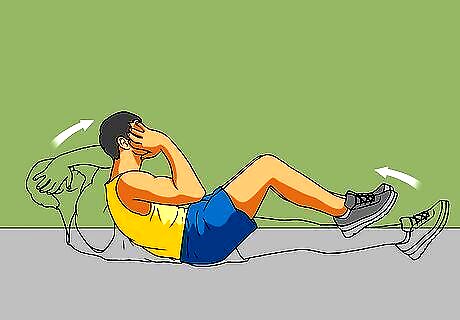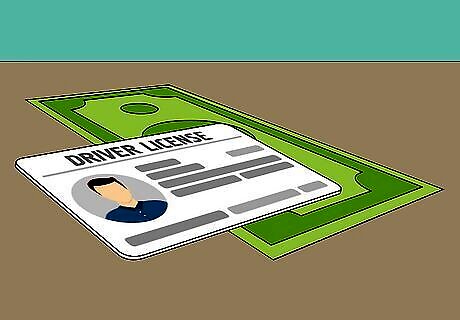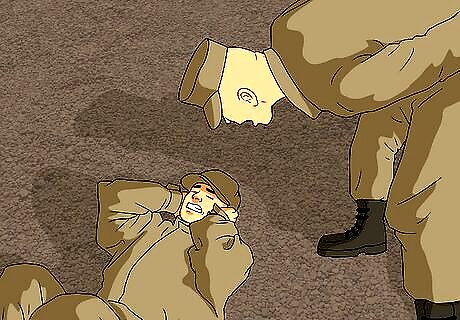
views
Physically Preparing for Boot Camp

Be aware of the tests you will face. Physical fitness is one of the core pillars of the Marine Corps' effectiveness. As such, Marines are expected to be able to prove their strength and endurance. Poolees must pass the Initial Strength Test (IST) at the beginning of their training and the Physical Fitness Test (PFT) at the end of their training to become Marines. Additionally, Marines are subjected to an annual test called the Combat Fitness Test (CFT). Knowing the passing standards for these tests can help you judge your physical ability before arriving at boot comp.

Learn the standards for the Initial Strength Test. The IST takes place at the end of the initial three-day "Receiving Phase" of Marine boot camp. The three components of the IST are Pull-ups/Flexed-arm hangs, crunches, and a timed run. Pull-up/Flexed-arm hang: Men must be able to complete two full pull-ups to begin training. Women need to be able to hold a flexed-arm hang (starting in the "up" position of a pull-up and maintaining elbow flexion for as long as possible) for twelve seconds. Crunches: Both men and women must be able to complete 44 full crunches (elbows or forearms to knees) in two minutes. Timed run: Men must be able to run 1.5 miles (2.4 km) in 13:30, while women must be able to run the same 1.5 mile (2.4 km) course in 15 minutes.

Learn the standards for the Physical Fitness Test. The exercises in the PFT are the same as in the IST, but the standards are more difficult. These standards assume a 17-26 year-old poolee - standards decrease slightly with age. See below: Pull-up/Flexed-arm hang: Men must be able to complete three full pull-ups. Women must be able to hold a flexed-arm hang for 15 seconds. Note that, although the Corps originally planned to extend the three pull-up requirement to women in 2014, this has been delayed. Crunches: Both men and women must be able to complete 50 full crunches in two minutes. Timed run: Men must be able to run 3 miles (4.8 km) in 28 minutes, while women must be able to run 3 miles (4.8 km) in 31 minutes.

Learn the standards for the Combat Fitness Test. Passing the CFT is an annual requirement for all Marines. The CFT tests the Marine's ability to apply his or her physical abilities in combat situations. The CFT has three components, each with a maximum score of 100 points. Thus, a perfect score in the CFT is 300 points. Minimum scores for each test vary based on the recruit's age and sex. Movement to combat: This is a timed 880-yard obstacle course that tests the Marine's speed and endurance. A maximum score is 2:45 for men and 3:23 for women. Ammunition lift: The Marine must lift a 30-lb box of ammunition over his or her head (until his or her elbows lock) as many times as possible. A maximum score is 91 repetitions for men and 61 repetitions for women. Maneuver under fire: This shuttle run incorporates a variety of combat tasks, including running, crawls, carries, throwing grenades, and more. A maximum score is 2:14 for men and 3:01 for women.

Aim to beat the minimum standards. Being able to just barely pass the minimum standards of the IST upon arrival at boot camp is not advisable. Recruits who scrape by the IST will have the hardest time adjusting to the intense physical demands of Marine life. In addition, they are more at risk for injury than other recruits and may be required to enroll in remedial strength and cardio courses. These things distract from the recruit's combat training and make it more difficult (but by no means impossible) for him or her to become a Marine. So, it's a smart idea to be able to pass the IST with ease and to be, at the very least, well on your way to passing the PFT by the time you arrive. Use the months before your ship date wisely!

Begin a running regimen. In addition to being able to pass the running portions of the IST and PFT, Marines are expected to be quick on their feet and to have high aerobic endurance so that they can hustle from task to task. Your running routine should be a combination of jogging, running and sprints in order to increase your quickness. As you run, be sure to breathe deeply, maintain a quick but reasonable pace, and maintain proper form. Your feet should make contact with the ground right in front of your heel - near the ball of your foot. Your point of contact should then "roll" forward, allowing you to push off with your toes. Many recruits have success using a form interval training to increase their aerobic endurance and decrease their run times. Below is a sample interval training regimen from Military.com. Let's assume a goal pace of 6 minutes per mile, which equals 3 minutes per ⁄2 mile (0.8 km), 90 seconds per ⁄4 mile (0.4 km), etc.: Run ⁄2 mile (0.8 km) at your goal pace. Walk or jog ⁄4 mile (0.4 km) to rest. Repeat the above two steps 4-6 times. Run ⁄4 mile (0.4 km) at your goal pace. Walk or jog ⁄8 mile (0.2 km) to rest. Repeat the above two steps 4-6 times. Run ⁄8 mile (0.2 km) at your goal pace. Walk or jog 100 yards (91.4 m) to res. Repeat the above two steps 4-6 times. Aim to consistently perform your running regimen, whether it's interval training or single, long runs, 4-5 times per week.

Plan a hiking regimen. Marines are expected to be able to march and move through difficult terrain while carrying their gear with them. Make a habit of hiking - it's great exercise and will increase your endurance, toughen your feet, and develop your back, ankles, and other muscles for the outdoor activities that are part of Marine life. When you hike, take a heavy camping-style backpack. You may also want to place weights in it to better simulate the feeling of hiking around terrain with a 30-60 lb. pack containing munitions, clothing, gear, etc.

Begin practicing pull-ups or flexed-arm hangs. Pull-ups and flexed-arm hangs are core components of the IST and PFT for men and women, respectively. Both exercises are feats of upper-body strength, using multiple muscle groups essential for combat effectiveness. To perform full pull-ups, first grab onto the bar with your hands facing toward or away from you. Hang from the bar with your arms fully extended. Your knees can be straight or bent, but they cannot be bent past your waist. From the rest position, raise your chin until it is above the bar, then lower your body until your arms are completely straight, pause, and repeat. In order to train for the pull-up test, you will want to purchase a pull-up bar or a membership to a gym with suitable pull-up equipment. If you're unable to do a pull-up, you may slowly build up your ability by using an assisted pull-up machine or asking a friend to spot you by grabbing your legs and supporting some of your body weight. Finally, you can make pull-ups easier by beginning at the top and lowering yourself down or by kicking your legs to increase momentum. You may also want to strengthen your upper back, biceps, and triceps through strength-training exercises. Women are required to pass a flexed arm hang test, rather than a pull-up test. They do, however, have the option to do pull-ups. Like men, women should build their back, bicep, and tricep strength by lifting weights, performing assisted pull-ups, and, of course, working on increasing their flexed-arm hang time.

Begin a swimming regimen or take a swim class. In addition to meeting the standards of the IST and PFT, Marines are expected to be good swimmers. If you have never learned to swim and properly balance yourself in the water, the Marine swimming tests will be quite difficult to pass. You should be able to swim over a mile without stopping. Try swimming 3 times per week for 45 minutes each day to increase lung capacity and build up your legs, shoulders and arms for endurance. Marine swimming qualifications now come in three levels: Basic, Intermediate, and Advanced. Every Marine must achieve Basic certification, which requires the Marine to shed his or her gear in the water in less than 10 seconds, jump off of a tower into the water and tread water for four minutes, and then pull his or her pack across the length of a 25-meter pool. These must be done in uniform, including boots. Many public pools, schools and gyms offer swim classes. If you are unsure whether you are performing the crawl stroke or underwater swimming strokes correctly, take a class to improve your form.

Do ab exercises every day. Core strength, as measured by crunches, is one of the core components of both the IST and the PFT. In addition, building your core is a vital step for avoiding injury to your back, which can result from intense exercise (especially while carrying heavy loads). Be sure to introduce a well-rounded ab routine into your weekly fitness plan - you'll want to work your obliques, lower abs, and hips frequently - every day, if you can. Sit-ups, crunches, planks, and hanging leg raises are great choices for increasing your ab strength The crunch component of the IST and the PFT is, in a sense, a speed test - don't forget you have a time limit of two minutes to complete your crunches. Do your ab exercises as quickly as you can while maintaining proper form and control. You may want to use a stopwatch to record your time. Core strength isn't just about your abs. Other good exercises for crucial, injury-preventing core strength are squats, lunges, and deadlifts. Use proper form with these exercises to avoid back strain.

Eat a lean, healthy diet. A proper diet is absolutely essential for building the muscle you'll need to meet your physical requirements as a Marine. Your diet should consist of healthy carbohydrates, protein and fats. Cut down (and aim to eliminate) sugars, excessively fatty foods, and preservatives from your diet. It's worth noting that Marines are expected to keep a healthy level of body fat - if they exceed certain standards for weight and body fat composition, they are enrolled in a weight loss program. Failure to pass this program can potentially result in discharge. When it comes to carbohydrates, try to get the majority of your carbs from leafy green vegetables, fruits, and healthy whole grains. Limit your starches like sliced bread and potatoes. Proteins should come from lean meats with proportions that are approximately the size of your palm. Healthy fats are found in nuts, eggs and vegetable oil and should be served in proportions approximately the size of a golf ball. Upon arrival in boot camp, people who are deemed underweight for their size will be given weight boosting rations. People who are deemed overweight will be given a calorie restricted diet. Training for boot camp in advance can help you to gain or lose body weight so that you fit in your standard weight category. While training for boot camp, eat 3 well-balanced meals per day, with a snack between breakfast and lunch and lunch and dinner. This will help your body to recover from training sessions and stay healthy. As you get closer to boot camp, try to eliminate the snacks, since they will not be part of boot camp.

Maintain a high level of hydration before, during, and after workouts. Hydration is an essential part of any workout routine. Since the workouts you'll undergo as a Marine may very well be the most intense you'll have to deal with in your life, it's a very smart idea to develop good hydration habits before boot camp. Drink plenty of water every day - more so if you exercise. Drink electrolyte drinks (like Gatorade, etc.) during intense endurance training to help refuel your body's supply of electrolytes, which are lost through sweat. In general, you should aim to drink 1 oz. of water for every 2 lbs. of body weight, or about 8-12 cups of water a day for large men. Low fat milk and, depending on the sugar content, pure fruit juice are also healthy hydrating drinks. Keep in mind that the two Marine Corps boot camps are located at Parris Island, South Carolina, and in San Diego, California. Both of these locations can be very hot, depending on the time of year, so hydration may become an even more important part of your workout than it was previously, especially if you're used to a more mild climate.
Mentally Preparing

Prepare to be treated as if you are worthless. If the Marine Corps' boot camp were solely about becoming physically fit, it would be difficult, but manageable for nearly all recruits with a willingness to work hard. What makes boot camp for Marines so incredibly demanding is that it also is an intense test of a recruit's abilities of intelligence, focus, and character - in short, their mental strength. Even athletic recruits sometimes wash out of boot camp because of the mental stress they're put under. Upon arrival at boot camp, be ready to immediately be thrust into a world where you are not entitled to the courtesy and respect you are accustomed to from civilian life. Get ready to be shouted at, insulted, disrespected, embarrassed, and otherwise treated like dirt. Also, prepare to obey the very people who are shouting at you and insulting you at the drop of a hat, because any laziness or back-sass on your part will be met with harsh consequences.

Prepare to live with only the bare essentials. Marine boot camp is no place for personal luxuries. Recruits are expected to leave everything but the absolute essentials at home. Below are the bare necessities recommended by Military.com for boot camp: Valid Driver's License or Photo ID Approximately $10-20 The clothes on your back Certain other minor accoutrements may also be allowed - talk with your recruiter to be sure of what items you'll need and/or be allowed to bring: Orders and documents issued by your recruiter Social Security Card ATM card Proof of citizenship (if not born in US) Marriage license and/or birth certificates for dependents Phone Card Bank Routing and Acct. numbers Religious materials Small lock (combination or padlock) Men: Three sets of white underwear Women: Panties, bras, nylons, one full slip (all neutral colors) One pair athletic socks One-day supply of civilian clothing Toiletries Do not bring the following luxuries: Phone Computer Watch Extra Clothing Makeup Food

Prepare to leave your loved ones for 13 weeks. Marine Corps boot camp is an endeavor that lasts over three months. During this time, your contact with your friends and family back home will be very limited. Usually, recruits are given one phone call of about 30 seconds to notify their family that they have arrived safely soon after arriving. After this, phone use is very limited, if it is allowed all. Some DI's may give phone time as a reward, while others may not. To be conservative, plan on not using the phone until the last week of training, if at all, and plan on not seeing your loved ones until Family Day, which takes place the day before your graduation. Your family and loved ones may send you letters, but even this comes with several stipulations. Letters should be completely plain and unadorned with no decorations or special envelopes and addressed to "Rct. (Recruit) Last Name, First Name". Make sure your family members understand not to specify a rank other than "recruit", not to send frilly or decorative envelopes, and to not send packages. These things will call undesirable attention to you.

Be prepared to unquestioningly follow your drill instructors' orders. Marine Drill Instructors (or "DI's") have achieved a legendary status for their tough, confrontational instruction style. They are loud, mean, and in-your-face. However, they are fair - they will absolutely not ever coddle any single recruit or allow him or her any special mercy. Understand that, by pushing you to your limits, the DI is, in a sense, helping you. Marine Corps life isn't easy - as a Marine, you may even be called upon to give your life for the country. To be an effective Marine, you must be capable of making level-headed decisions in the middle of a battlefield. As tough as the DI's are, you may find eventually that you're glad they were able to instill Marine values of strength and discipline in you if you are ever involved in combat. Even the slightest mistakes can warrant punishment. Merely looking at a DI incorrectly can get you a tongue lashing; a tiny mistake when cleaning your rifle can lead to what is called Incentive Physical Training (IPT), i.e. being ordered to do push-ups, mountain climbers, side straddle hops (AKA jumping jacks), leg lifts, etc. By holding you to incredibly exacting standards, the DI's help you gain the strength and attention to detail you'll need in the field.

Lose your ego. One of the very first things that happens to recruits at boot camp is for their hair to be altered to meet military specifications. Men are more or less shaved bald, while women receive short haircuts or have their hair tied in a bun. This is done for an important reason. Marines are expected to sacrifice their individuality for the benefit of the unit. This extends from the relatively simple - giving up a personal appearance that sets you apart from the group - to the profound - laying down your life for another. Be ready to set aside your ego when you step off the bus at boot camp. From that point forward, your country and your fellow Marines are your first priority, not yourself.

Get ready for plenty of "head games". Marine DI's will frequently subject recruits to various tasks and situations that are meant to break their spirits so that they can be rebuilt as perfect Marines. DI's constantly look for opportunities to stress, humiliate, and otherwise "break down" recruits. They may force them to complete tasks that are impossible, then punish them when they are unable to complete them. They may arbitrarily single out and pick on recruits for no reason. Their actions may seem unfair - they are, and they are meant to be! However cruel a DI's behavior may seem, remember that it's not personal - all recruits go through boot camp and have similar experiences. Here are just a few examples of "head games" from one former recruit, now an active duty Marine: A foot locker was left unlocked, so all the recruits were made to lock their locks together in several balls and throw these balls onto the floor. The recruits then had one minute to find and unlock their own personal lock. After they failed this impossible test, they were punished with insults and physical training. After winning a drill competition, recruits were punished with physical training in a mud pit because they didn't win by a big enough margin. Marines are not allowed to let their platoon's guidon (a special type of flag) touch the ground. While standing at attention, Marines are not allowed to move unless told to do so. A DI would throw the guidon at the ground in a show of disgust at his platoon's performance. When recruits broke ranks to dive and catch it, they were punished.

Be ready to lose sleep. A Marine's duties usually begin before sunrise. If you're not an early riser, you will probably want to begin adjusting your sleep schedule long before your ship date to ease the transition into your boot camp routine. Additionally, sleep deprivation is part of basic Marine training. For instance, during the defining test of recruit training called The Crucible, Marine recruits embark on a 54-hour mission on which they receive only about 4 hours of sleep. Sleep deprivation prepares the recruit for life in a combat zone, in which he or she may be asked at any moment to fight, whether he or she is well-rested or not.

Be prepared to be held accountable for every action you take. During boot camp, recruits learn to rely on each other and to hold each other up to high standards. Platoons frequently compete for trophies that earned for cumulative scores in marksmanship, academics, etc. Because the platoons are judged as a whole, the members of each platoon rely on each other to perform to the best of their ability. Remember, also, that platoons are often punished as a whole for the mistake of a single member, so it's in every recruit's interest to both hold his fellow recruits accountable for their actions and to be held accountable for his or her own actions.




















Comments
0 comment